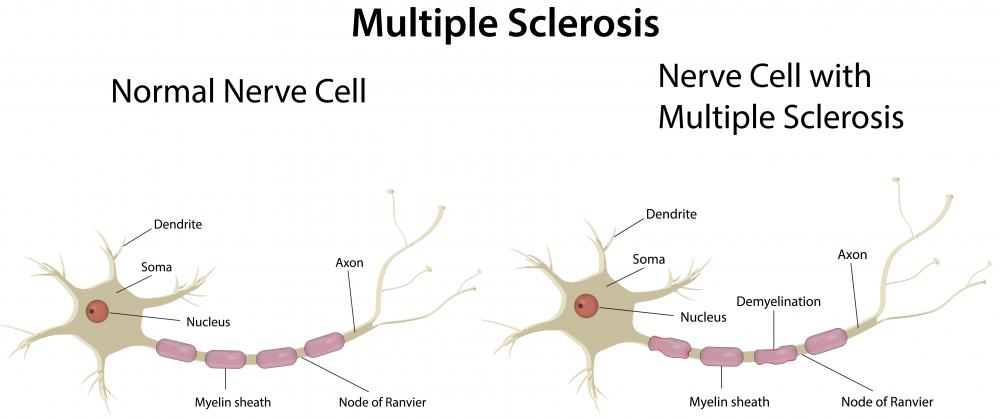At TheHealthBoard, we're committed to delivering accurate, trustworthy information. Our expert-authored content is rigorously fact-checked and sourced from credible authorities. Discover how we uphold the highest standards in providing you with reliable knowledge.
What Is the Importance of Myelin?
Myelin is a substance which encloses the axons of neurons, providing electrical insulation that helps the nervous system function. The importance of this substance is most evident in the types of diseases that develop when it is damaged or destroyed. Demyelinating diseases, such as multiple sclerosis, are degenerative conditions that can cause vision and hearing loss, progressive loss of limb function, and many other muscle coordination and control-related symptoms.
Neurons are the cells that make up the central nervous system. Each cell has a long tail-like structure called an axon, which extends into the extracellular space. Axons make contact with other axons, or with muscle or gland cells, transmitting nerve impulses in the form of electrical energy. Myelin, a fatty protein, coats each axon in a layer called a sheath. This protein is a dielectric material, which means it provides electrical insulation to the axon within the sheath.

The electrical insulation that this protein provides has two important roles that contribute to and are essential for healthy nervous system function. One of these is that myelin helps to keep electrical current within the axon. It does this in two ways: by increasing its electrical resistance, and by decreasing its capacitance. Increasing electrical resistance prevents electrical energy from being lost outside the cell, while decreasing capacitance reduces the ability of the axon to store electrical energy.

The main function of the protein is to help nerve impulses move along the axon, increasing the speed at which these impulses are able to travel. It does this via a process called saltatory conduction, which allows impulses to “skip” along the axon, similar to the way in which a thrown stone can skip along the surface of water. This skipping motion allows impulses to travel faster than they would if they had to travel along the entire axon.

Myelin is essential for healthy nerve function. Without it, axons become much less efficient at transmitting electrical energy, resulting in symptoms of disease when large numbers of axons become demyelinated. Many of the most well-known demyelinating diseases, including multiple sclerosis, are the result of an autoimmune reaction in which the immune system progressively destroys myelin in the central nervous system. Destruction of this essential protein reduces the rate at which electrical impulses travel along axons, leading to substantial disruption of the nervous system. The human body is able to repair this destruction at a very limited rate, but the progression of demyelinating diseases eventually far outstrips the ability of the body’s repair systems.
AS FEATURED ON:
AS FEATURED ON:














Discussion Comments
MOG Myelin is Myelin Oligodendrocyte Glycoprotein and is thought to be important in the coating of the nerves with myelin. It is thought to be targeted in the autoimmune disorder multiple sclerosis which damages the myelin on the brain, spinal chord and optic nerves.
Post your comments